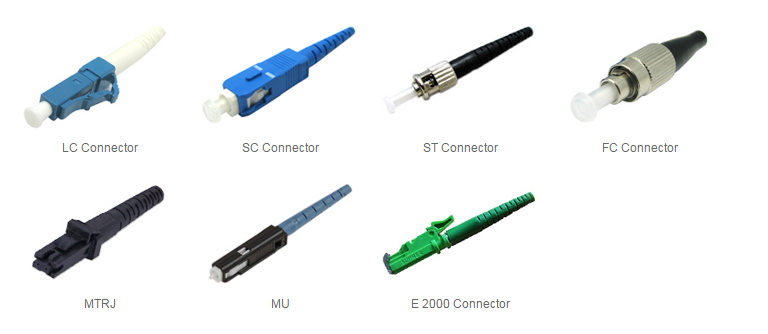As we know, fiber patch cords are capped at both ends with fiber optic connectors to allow them to be rapidly and conveniently connected to telecommunication equipment and to achieve accurate and precise connections. Fiber optic connector is a very important part of the fiber patch cords. This article mainly talks about what fiber optic connector is, four common types of fiber optic connectors and its relationship with fiber patch cords.
What Is Fiber Optic Connector
This question can be answered in two ways. Functionally, a fiber optic connector terminates the end of an optical fiber, and provides a separable connection between two elements of an electronic system without unacceptable signal distortion or power loss. Structurally, every connector includes several parts, two permanent interfaces, the contact springs in each half of the connector, the separable interface and the connector housing which maintains the location of the contacts and isolates them from one another electrically. The connectors mechanically couple and align the cores of fibers so light can pass. To achieve less light loss, more and more better connectors are made to provide more accurate misalignment of the fibers.
Four Common Types of Fiber Optic Connectors
Connector types of the patch cable must match the patch panels and equipment so that the patch cable can function well. There are many different connectors in use for fiber optic patch cords. The text below is a brief overview of four common connector types. The following picture shows some common fiber optic connectors.

LC connector is a small form factor plastic push/pull connector with a 1.25mm ferrule. LC was first developed by Lucent. LC connector has a locking tab and a plastic housing and provides accurate alignment via its ceramic ferrule. LC has been referred to as a miniature SC connector.
SC connector is a plastic push/pull connector with a 2.5mm ferrule. It requires less space in patch panels than screw on connectors. For its low cost, simplicity and durability, SC connector is the second most commonly used type for polarization maintaining (PM) connections. Like LC connector, SC connector also has a locking tab and provides accurate alignment via its ceramic ferrule.
FC connector is a metal screw on connector with a 2.5mm ferrule. It is extensively used at the interfaces of test equipment due to its ruggedness. FC connector is the most common connector used for PM connections. And it features a metal housing, a position locatable notch and a threaded receptacle. FC connectors are nickel-plated.
ST connector is a metal bayonet coupled connector with a 2.5mm ferrule. It can be inserted into and removed from a fiber optic cable both quickly and easily. ST connectors are nickel-plated, keyed, spring-loaded and constructed with a metal housing. It has push-in and twist types.
All these four types of fiber optic connectors have different constructions and their respective applications. And there are many other kinds of fiber optic connectors, such as MU, MTRJ, E2000, SMA, etc. One important criterion for choosing fiber patch cord is to choose one with the most appropriate connector type that meets your needs.
Fiber Optic Connectors and Fiber Patch Cords
Fiber optic connector is an essential part of fiber patch cords. Generally, many fiber optic connectors can be manufactured for both single mode and multi-mode, simplex and duplex fiber patch cables. And fiber patch cord can have the same or different connectors at its both ends. For example, LC-LC single mode simplex fiber patch cord is a single mode simplex fiber patch cable with a simplex LC connector on each end, or SC-LC multi-mode duplex fiber patch cord is a multi-mode duplex fiber patch cable with a duplex LC connector on one end and a duplex SC connector on the other end.
Originally published at http://www.fiber-patch-cords.com/blog.html
没有评论:
发表评论